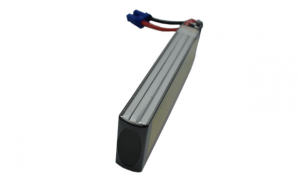Advantages of polymer lithium battery:
(1) The safety performance is good. The polymer lithium battery adopts aluminum-plastic soft packaging in the structure, which is different from the metal shell of the commercial battery. Once a safety hazard occurs, the lithium ion battery is easy to explode, while the polymer battery will only blow up. , The most is burning.
(2) Small thickness can be made thinner. The thickness can be less than 1mm, which can be assembled into a credit card. There is a technical bottleneck for ordinary liquid lithium batteries to be less than 3.6mm thick, and 18650 batteries have a standard volume.
(3) Light weight and large capacity The battery using polymer electrolyte does not need a metal shell as a protective outer packaging, so when the capacity is the same, it is 40% lighter than a steel shell lithium battery and 20% lighter than an aluminum shell battery. When the volume is generally large, the capacity of the polymer battery is larger, about 30% higher.
(4) The shape of the polymer battery can be customized. The thickness of the battery cell can be increased or reduced according to actual needs. For example, a new notebook of a famous brand uses a trapezoidal polymer battery to make full use of the internal space.
Advantages of 18650 lithium battery:
1. Wide range of use
Widely used in various electronic equipment, such as notebook computers, walkie-talkies, portable DVDs, instruments, audio equipment, aviation models, toys, camcorders, digital cameras, etc.
2. Series
Can be combined in series or parallel to form a 18650 lithium battery pack.
3. Low internal resistance
The internal resistance of polymer batteries is smaller than that of ordinary liquid batteries. The internal resistance of household polymer batteries can even be less than 35mΩ, which greatly reduces the self-consumption of the battery. This kind of polymer lithium battery that supports large discharge current is an ideal choice for remote control models, and it has become the most promising product to replace Ni-MH batteries.
4. No memory effect
There is no need to empty the remaining power before charging, which is convenient to use.
5. High voltage
The voltage of 18650 lithium battery is usually 3.6V, 3.8V and 4.2V, which is much higher than the 1.2V voltage of nickel-cadmium and nickel-metal hydride batteries.
6. High safety performance
18650 lithium battery has high safety performance, non-explosive, non-combustible; non-toxic, non-polluting, RoHS trademark certification; cycle times greater than 500 times; good high temperature resistance, discharge efficiency up to 100% at 65 degrees. In order to prevent the battery from short-circuiting, the positive and negative electrodes of the 18650 lithium battery are separated.
Therefore, the possibility of its short circuit has been minimized. A protection board can be added to avoid over-charging and over-discharging the battery, which can also extend battery life.
7. Long life
The 18650 lithium battery has a long service life, and the cycle life can reach more than 500 times in normal use, which is more than twice that of ordinary batteries.
8. Large capacity
The capacity of 18650 lithium battery is usually between 1200mah~3600mah. If 18650 lithium batteries are combined to form a 18650 lithium battery pack, the 18650 lithium battery pack can easily exceed 5000mah.
2. The difference between 18650 lithium battery and polymer lithium battery:
1. Different raw materials The raw material of lithium ion batteries is electrolyte (liquid or gel); the raw materials of polymer lithium battery are electrolytes including polymer electrolyte (solid or colloidal) and organic electrolyte.
2. In terms of safety, lithium-ion batteries are prone to explode in a high-temperature and high-pressure environment; polymer lithium batteries use aluminum plastic film as the outer shell, and when organic electrolytes are used inside, they will not explode even if the liquid is very hot.
3. Different shaped polymer batteries can be thinned, arbitrarily shaped, and arbitrarily shaped. The reason is that the electrolyte can be solid or colloidal rather than liquid. Lithium batteries use electrolyte and require a solid shell as the second The secondary package contains electrolyte.
4. The battery cell voltage is different. Because the polymer battery adopts polymer materials, it can be made into a multi-layer combination in the battery cell to achieve high voltage, while the nominal capacity of the lithium battery cell is 3.6V, if you want to achieve high voltage in actual use , You need to connect multiple cells in series to form an ideal high-voltage working platform.
5. With different manufacturing processes, the thinner the polymer battery, the better the production, and the thicker the lithium battery, the better the production, which makes the application of lithium batteries more expandable.
6. The capacity of the polymer battery has not been effectively improved, and it has been reduced compared with the standard capacity lithium battery.
7. 18650 battery life theory is 1000 cycles of charging. Because of the large capacity per unit density, most of them are used in laptop batteries. In addition, because the 18650 has a very good stability at work, it is widely used in various electronic fields: often used in high-end glare flashlights and portable Power supply, wireless data transmitter, etc. Polymer batteries are mainly used in mobile phones and mobile DVDs.
8. Different electrolyte materials: liquid lithium-ion batteries use liquid electrolytes, while polymer lithium-ion batteries use solid polymer electrolytes instead.
Post time: Sep-23-2021





